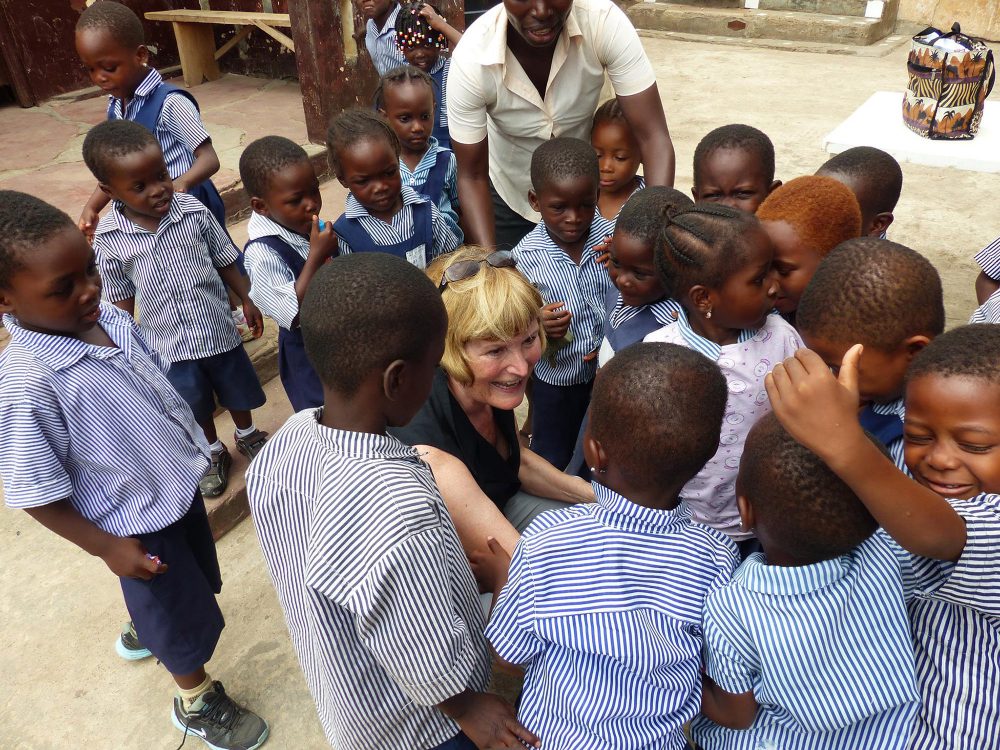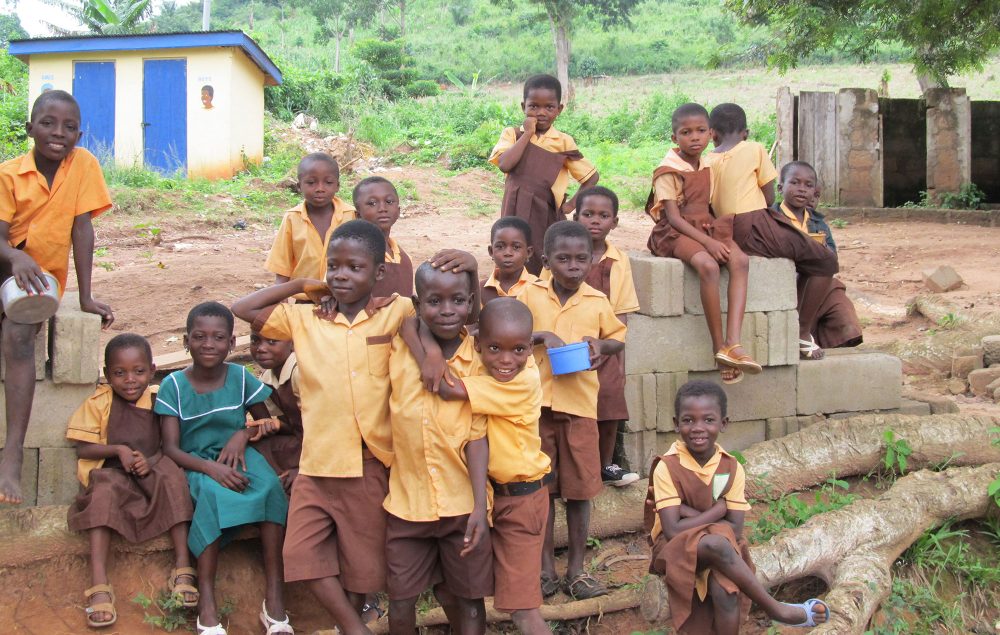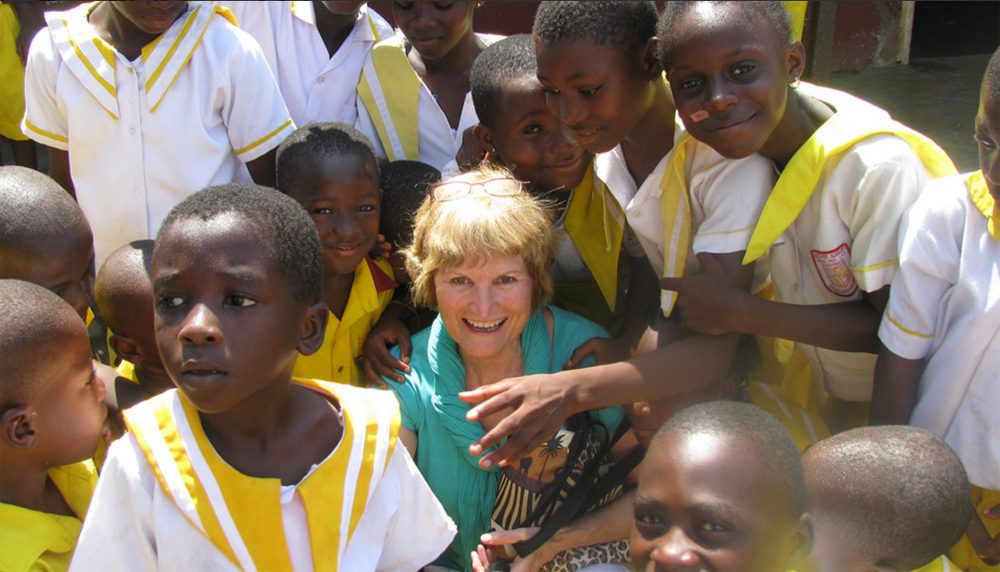Some people are born teachers. Not only do they follow a path to their calling, they recognize that education is an important resource that should be accessible to everyone - no matter how they learn, no matter where they live.
Anne Kinch (Tessier) has always been passionate about teaching and learning. She is a primary school specialist, librarian, social adjustment, physical education and classroom teacher, and has taught every grade from junior kindergarten to grade eight. Anne's work with the York Region District School Board combined with her training as a Reading Recovery teacher led her to analyze how children performed tasks in mathematics. After her five-year long research project on this, she applied her studies to help children improve their abilities and confidence in both mathematics and literacy.
Most recently, Anne has broadened her reach beyond Toronto and Canada to Ghana, Africa where, as part of the organization Our Children Africa (co-founded by her daughter Shannon), she trains teachers in the Every Child’s Path program.
Our Children Africa is a Canadian organization whose mission is to provide quality Africentric education with an emphasis on literacy, leadership development, and reproductive health education. Its goal is to empower children through education to remove the barriers which prevent them from escaping the cycle of poverty.
What inspired you to begin Every Child's Path?
When I was trained as a Reading Recovery Teacher, founder Marie Clay's words really spoke to me: "children who make slow progress in reading, haven't learned how to look at the print." This means they are missing some of the details they need. Next, I began thinking about why we don't have math recovery and thought about how I would do that, especially since I saw many of my reading recovery students getting extra help in mathematics, in addition to literacy. I pondered this aloud to my superintendent, and she asked me about my thoughts on this at the time and we revisited it a year later. This is when it became more personal for me, and something I knew I had to act on. My superintendent helped me get involved in an action program in York Region where I worked with other teachers also doing research.
Almost the first day of my research I was introduced to the work of Doug Clements, a math professor, who has determined that it's easiest for children to learn to see things like print or numbers, in a sequence of frameworks like a box, then a row (reading and writing), and finally a circle. That for me was huge because I knew that we have to show children how to look at print no matter what it is (letters, numbers, patterns) in the box.
When I combined the work of Marie Clay with the work of Doug Clements, I developed a new program where children learn to look at print in a box (or mat) framework.
What are some misconceptions you've seen in terms of the way children learn?
I find that the biggest misconception is from teachers who think that children understand basic concepts when they don't. I don't know if there is enough time for teachers to explore different methods of learning that will work for everyone.
Howard Gardner of Harvard has identified seven distinct intelligences that influence how people can learn (visual-spatial, bodily-kinesthetic, musical, interpersonal, intrapersonal, linguistic, and logical-mathematical). When we introduce a new concept to students, it is best to show what this looks like in many different ways, since we all learn differently. Unfortunately, most teachers don't have the time to practice this to determine what method of learning works best for each child. If we don't explore all options, odds are we'll miss someone.
Can you tell us about your training as a reading recovery teacher and what that means?
The goal of reading recovery is to provide learners with one-on-one tutoring for half an hour each day and within 12-20 weeks to bring their ability up to their grade level, so they'll be able to work within their current grade effectively and independently.
I was trained how to analyze what children are doing and the mistakes they are making. Each week you'd watch a teacher through one-way glass and then talk about the lesson. You learn how to design individual programs for each child based on what he or she already knows.
When creating Every Child's Path I wanted to give as much reading recovery information as possible to help teachers help children who are having difficulty and be able to put it into a workable lesson plan for their entire class.
Another thing I was really aware of in creating the program was how active children are, and incorporating that into my lessons. With the mats, I can teach with no papers or pencils, and kids are actively involved in their learning.
How do you use mats to teach the structure of a box?
A mat (box) replaces a paper as the children learn how letters, numbers, words, sets, subsets, patterns and sentences work and fit inside that box. When I start to focus on my program I am looking to spend four to five months to work on spatial awareness in all subjects.
The mat itself is a noticing mat. Children start by noticing things on the mat, an object or a toy, and you start asking questions. A big part of my program is asking questions to get kids to think; I call it guided noticing. It brings out a lot of language and the children have to answer in complete sentences. So many people in Ghana speak tribal languages, but by having children answer in complete sentences it was helping them improve in their national language, English.
They aren't using pens and papers but are learning a lot. It takes months to work through the basics. I ask a lot of questions like "how do you know?" and "why do you think?", so they are also becoming critical thinkers.
Next, I like to think of the mat as a map with a grid and a legend and a direction indicator. When we give children a paper they have no framework. I'd point to a corner, so I'd help them develop language around a corner and direction on the mat. It was a discovery method, so we'd find corners. When I ask questions their minds are thinking and they can get on and touch and jump on the corners. They are so engaged in the program, the behaviour isn't an issue.
So we'd work on edges by seeing the edges with objects in the corners. We'd name starting edge on the left, stopping on the right. This is how we build a framework as to where things (like letters and numbers) are placed. Next, we start naming top left as the starting corner, and on the diagonal at the bottom is the stopping corner. The other two corners are just called the top and bottom corners. So it's an easy framework.
Then I'd just bring wool and we can make a number 2 on the mat and children can line-up and look where it starts or stops. The children can walk along the wool beginning from the starting edge and going along to the bottom corner.
How has education evolved since you first began working with children?
When I was completing my research to create Every Child's Path, I explored how much of the kindergarten curriculum involved spatial awareness. I discovered that this important element in literacy is sadly only covered for about a week or two of school.
I haven't seen much change, however, the biggest development I've seen is how there is so much more curriculum taught nowadays. This gives teachers very little time to delve into other areas of interest with their students, which is unfortunate.
How do you keep yourself educated and up to date on trending issues and research in education?
I am looking at it from a different place since I am exploring methods that will work in remote villages with very little teaching supplies. So when I'm looking, reading the paper, hearing word of mouth or on the internet, I am looking at how to work the program in disadvantaged areas.
I recently explored a math program that looked good at first, but it had have so many computer-based lessons connected with it, it is difficult to translate to somewhere without this technology. When I work with some village schools we can go to the market, get a mat and some string or wool and that's all of the supplies we really need. I am currently re-working my book, getting rid of technological supplies such as overhead projectors in favour of a more simplistic approach.
What suggestions do you have for a parent of a child learning to read and write?
Really work on alphabet sounds and lower case letters and the sounds they make. There are alphabet books where the letter looks like the word. Lower case magnetic letters are a great way to get children to form words, move them apart, and then practice putting them back together.
Another key thing I saw happening when I taught grade one was that the boys were falling behind because they couldn't print quickly because of a lack of fine motor skills. So when I taught kindergarten we started a cutting club with paper and scissors to help build these small muscles. We'd cut across the paper and then zig zags to big curves and the kids would work on these before other activities. Then we'd continue building on this strength developed in printing club.
Tell us about your favourite projects.
In Ghana, I have worked with teachers who have a high school education and they have become passionate and wonderful teachers. I am so proud of the fact that they come up with such great ideas. They are training other teachers how to teach was well.
We started with one school years ago, and today have trained over 400 teachers who have taught thousands of children. I wanted to empower teachers to show them how to teach those who struggle, because once you can do this, then you're truly a teacher, and seeing this happen is so rewarding.
In addition to this training, we are building a school, and paying for teachers to get more education (two are learning about Montessori teaching). I can't wait for the school to be finished so I can be there and observe everyone learning.
What is your educational motto?
Before Every Child's Path, I took a primary education course and learned the teaching concept of never letting a child sit down with a wrong answer. Instead, help the child feel successful so they'll want to try again. From reading recovery, I learned to make children feel like they're stars because they won't get that a lot of the time. Let them understand that they are good, they are smart, and they are capable of doing all of this.
The quote: "nobody cares how much you know until they know how much you care," has been key to my successes. People participate in the program because they know how much I care. When people see me going to Ghana every year to teach seminars they know how much I care and want to get involved.
Support Our Children Africa by donating here - for example an annual tuition for a child is only $33!
SM00LR




